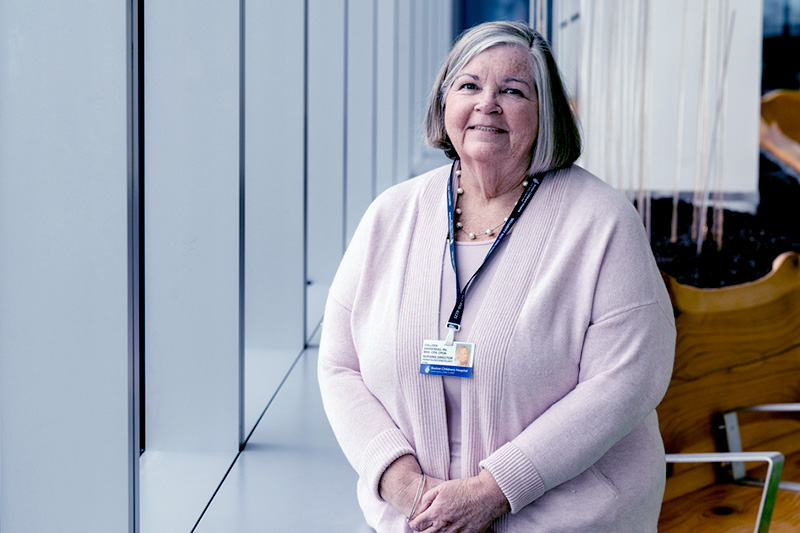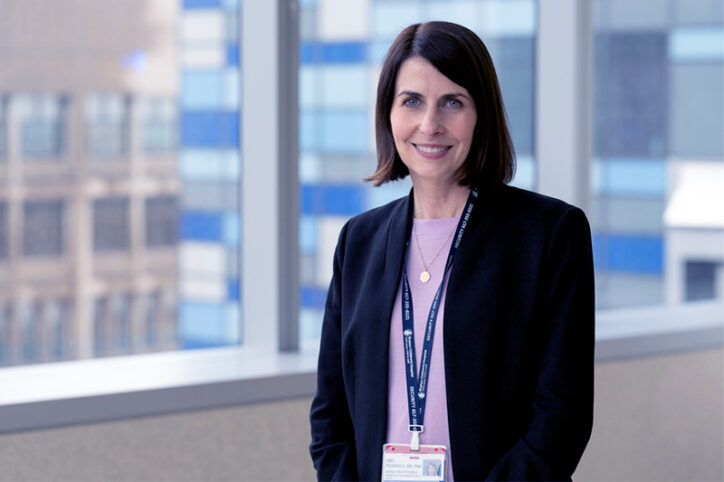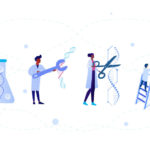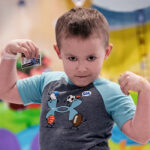In a thriving gene therapy program, nursing leadership is the driving force

Gene therapy was made possible by decades of technological advances. But to execute gene therapy at scale? That would not be possible without the foresight, organization, and innovation of nursing leadership at Boston Children’s Hospital. The gene therapy implementation framework they have built has become a gold standard for the field.
Founded in 2010, the Gene Therapy Program, directed by Daniel Bauer, MD, PhD, today offers nine FDA-approved gene therapies — and is designated by the product manufacturers as a Center of Excellence for all nine. The program is currently involved in about 20 clinical trials for multiple disorders, with another 20 trials in development.
Gene therapy — which might involve insertion of a healthy gene, editing a gene, or changing a single “letter” of a gene (called base editing) — stands out for its complexity.
“At least 25 people from 20 different disciplines intersect with each patient,” says Colleen Dansereau, MSN, RN, CPN, the program’s senior director of clinical operations.
Nursing manages the many steps involved for each patient, from educating patients and families to insurance authorizations to ensuring that every step happens in the right sequence.
“Everything is very carefully orchestrated. If one piece falls out, everything falls apart,” Dansereau says. “It’s incumbent on us to make sure all the pieces fall in line.”
Orchestrating the patient journey
Many of the gene therapies offered at Boston Children’s are ex vivo, meaning that patients’ own cells are treated and returned to them. It’s a complicated journey: A patient with sickle cell disease, for example, must be shepherded through a nine-month treatment process.

After three months of testing and blood transfusions, patients are admitted for three to four days on an apheresis machine to collect stem cells from their blood; in some cases, they may need to return for one or more cycles. Their stem cells are then sent to a cell manufacturing facility to be genetically altered (times vary; for FDA-approved sickle cell gene therapy, this takes four to six months). Patients then are admitted to the Stem Cell Transplant Unit for conditioning chemotherapy, the gene therapy infusion, and three to four weeks’ recovery in the hospital as the treated cells graft themselves into the bone marrow and start making new red blood cells.
“A big piece is care coordination for patients along their journey,” notes Amy Federico, MSN, RN, CPNP, who oversees clinical research trials of gene therapies. “Our patients pursuing gene therapy for sickle cell disease are older teens and younger adults who are trying to live their lives, but need a high level of support. It’s a lot of relationship-building.”
Strategic planning for complex therapies
Several years ago, Dansereau and colleagues in Nursing/Patient Care Operations, Pharmacy, Business, and Legal Services formed the Office of Emerging Medical Discoveries. Dansereau co-directs the office with Donna Casey, SVP of Strategic Business Planning, Analysis, and Budget.
As new gene therapies and other complex, high-cost treatments become available, the team develops operational and business strategies to “on-board” them, pulling in other groups such as Transfusion Medicine, the apheresis and infusion teams, the International Center, Child Life, and more.
“It speaks to the success of our model that we can go from FDA approval to patient-ready care delivery processes within three to four weeks,” says Dansereau.
A CENTER OF EXCELLENCE: GENE THERAPIES AT BOSTON CHILDREN’S
Ex vivo therapies (patients’ cells treated outside the body)
CASGEVY and LYFGENIA gene therapy for sickle cell disease
CASGEVY and ZYNTELGO for beta-thalassemia
KYMRIAH, a CAR-T cell therapy for refractory or relapsed acute lymphoblastic leukemia
SKYSONA for cerebral adrenoleukodystrophy
In vivo therapies (patients treated directly with the gene therapy vector)
LUXTURNA for inherited retinal disease
ZOLGENSMA for spinal muscular atrophy Type 1
ELEVIDYS for Duchenne muscular dystrophy
ROCTAVIAN for severe hemophilia A
Redefining care
When it comes to gene therapy, patient care involves an array of behind-the-scenes logistics. That can include sending Ubers to pick up patients at home, booking travel for international patients, and having infant formula delivered to families’ hotel rooms.
“We budget these things into our clinical trials,” says Dansereau. “If you’re a patient from Turkey and you don’t speak the language, they’re game-changers. Our philosophy is, you only have to worry about your child, we’ll worry about everything else.”
For many patients, care also includes fertility preservation — harvesting and protecting patients’ eggs, sperm, or reproductive tissue — since the chemotherapy required before ex vivo gene therapies can cause infertility. This, too, must be coordinated with providers at Dana-Farber/Boston Children’s Cancer and Blood Disorders Center and discussed with insurance companies.
“We’ve been influential in these conversations,” says Dansereau. “Payers consider Boston Children’s to be a thought leader and they solicit our input in crafting policies around gene therapy.”
The power of nursing, and the payoff
The Gene Therapy Program’s success is drawing international attention. Dansereau attributes much of its success to the involvement of nurses in a leadership capacity.
“By nature, nurses are expert problem-solvers and multitaskers,” she says. “Nurses think holistically. We’re patient-care focused and we see the whole picture from the beginning. That’s our secret sauce.”
Federico agrees. “Nurses tend to be inquisitive. We’re constantly evolving and changing; we love learning. We wear many hats: Education, advocacy, care coordination, research, and the social component.”
The payoff makes all the effort worthwhile.
“On the back end, we get to hear about our patients’ accomplishments: holding a job, getting into college ,” says Federico. “These are things that other people take for granted.”
“It’s rewarding to see kids able go to school or to get pictures of kids with Duchenne muscular dystrophy, adrenoleukodystrophy, or spinal muscular atrophy riding bikes or sitting up for the first time,” Dansereau says. “We’re proud to be able to bring these life-changing therapies to patients through the model we’ve developed.”
Learn more about the Gene Therapy Program at Boston Children’s
Related Posts :
-

After decades of evolution, gene therapy arrives
As early as the 1960s, scientists speculated that DNA sequences could be introduced into patients’ cells to cure genetic disorders. ...
-

Lucas receives gene therapy for DMD and finds his super muscles
Lucas Toro has a lot in common with Gekko, the cartoon character from PJ Masks. They’re both “little guys” ...
-

All in the family: Dynamic nursing duos in the Heart Center
Sometimes nursing runs in the family, and at the Boston Children’s Hospital Heart Center, we’re lucky to have ...
-

Making history: Gene therapy for CCALD gives Conner a second chance
Like a lot of 6-year-olds, Conner Hess finds joy in simple acts: drawing pictures, cuddling his two cats, and playing ...





